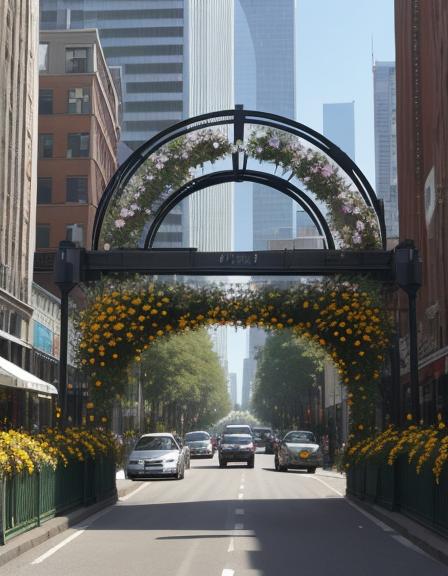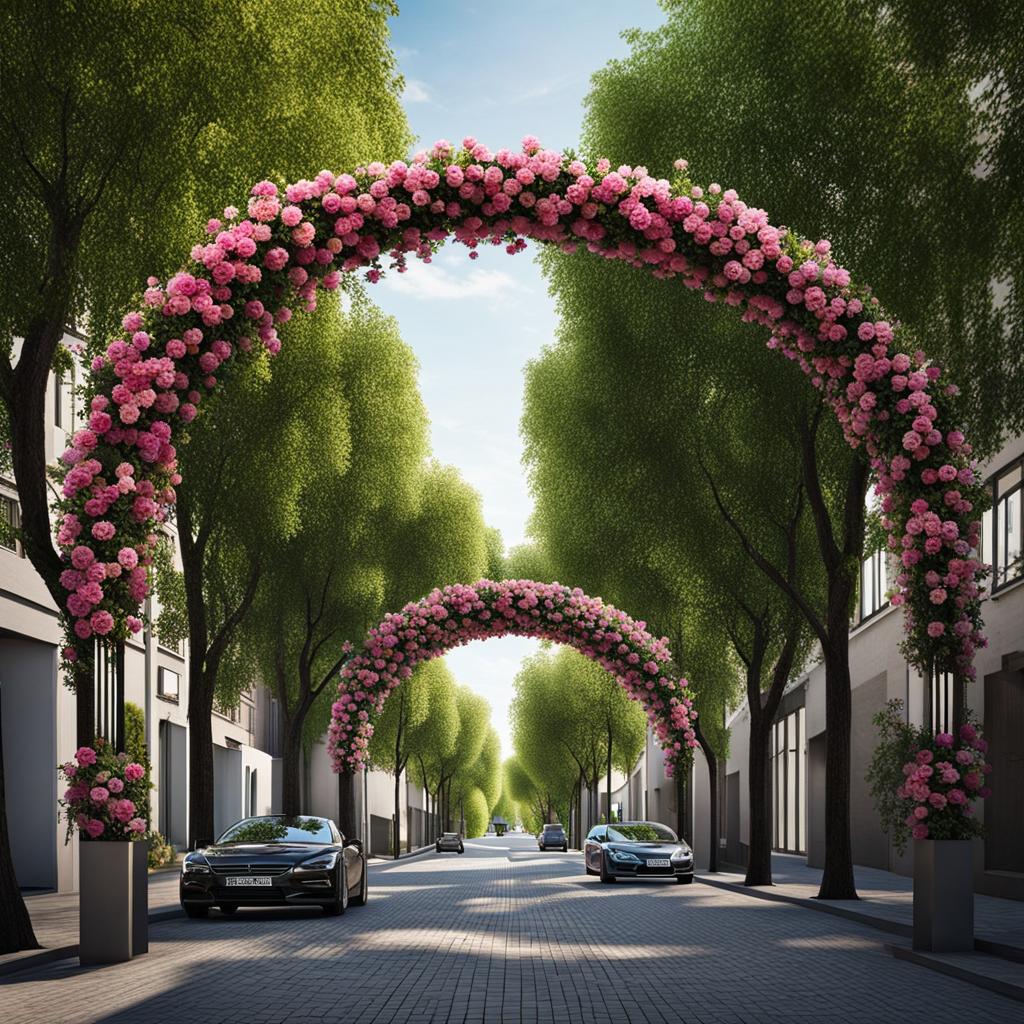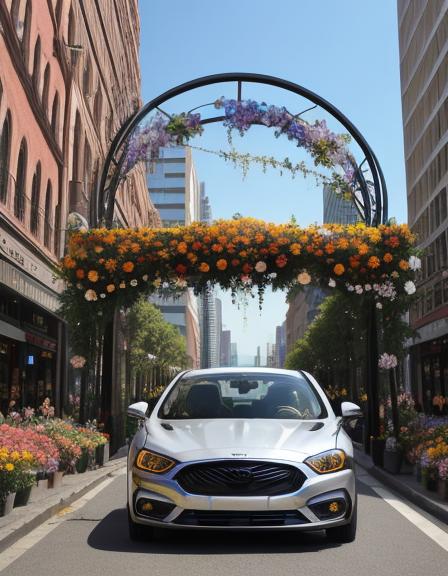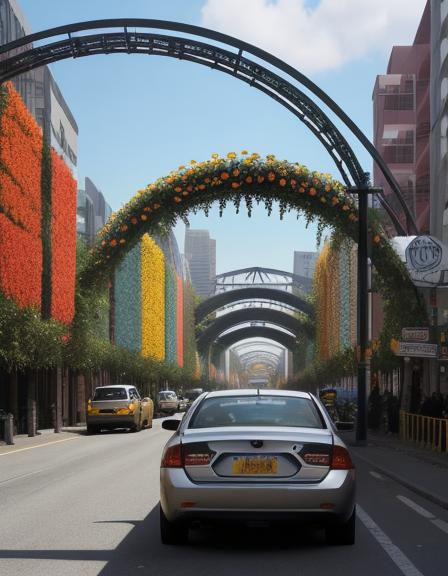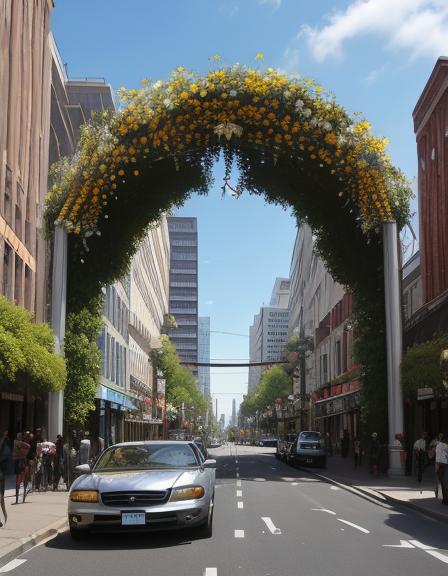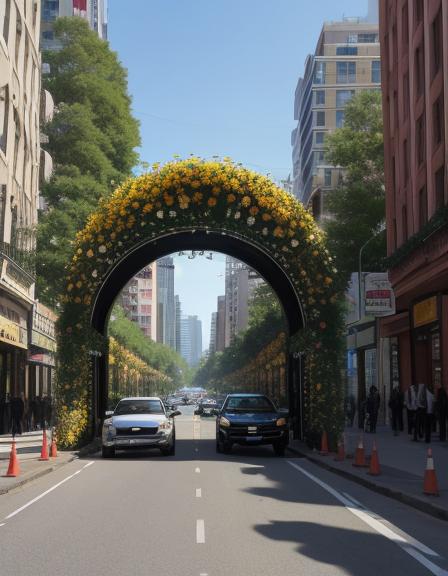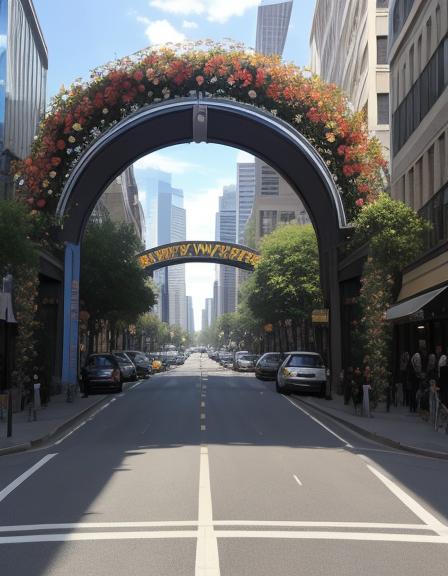Reconnecting with nature
Pollinator Pathways
Arches or towers of pollinator friendly plants to help them cross roads
Urbanization has taken a toll on the natural world around us, often leaving nature’s smallest but most vital creatures invisible. My idea to protect and integrate pollinators in urban areas is to build “natural bridges”, which are arched pathways filled with native, pollinator-friendly plants. These arches can be put in pedestrian paths or even car-congested streets, offering a safe passage for pollinators to cross and feed, all while keeping them out of harm’s way.
Portugal
National
Mainly urban
It refers to other types of transformations (soft investment)
Early concept
No
No
As an individual
Aim: Protect pollinators and enhance urban biodiversity by creating arched pathways filled with native, pollinator-friendly plants.
Target Groups: Pollinators (bees, butterflies), urban communities, and local governments.
Objectives:
- Provide safe habitats and food for pollinators.
- Raise public awareness about pollinators.
- Increase urban biodiversity and green spaces.
Outcomes:
- Pilot bridges installed with increased pollinator activity.
- Community engagement in conservation efforts.
- A scalable model for sustainable urban ecosystems.
This project supports urban sustainability and biodiversity conservation.
Target Groups: Pollinators (bees, butterflies), urban communities, and local governments.
Objectives:
- Provide safe habitats and food for pollinators.
- Raise public awareness about pollinators.
- Increase urban biodiversity and green spaces.
Outcomes:
- Pilot bridges installed with increased pollinator activity.
- Community engagement in conservation efforts.
- A scalable model for sustainable urban ecosystems.
This project supports urban sustainability and biodiversity conservation.
Green Infrastructure
Pollinators
Biodiversity
Sustainability
Urbanization
Sure! Here goes:
Objective 1. Enhancing urban biodiversity: the project directly contributes to the conservation of pollinators (by providing safely accessible new habitats and food sources), which are vital for our ecosystems and food chains.
Objective 2. Promoting Green Infrastructure, which is essential for mitigating the desertification caused by urbanization. This includes reducing heat island effects, improving air quality, and promoting rainwater absorption, all of which contribute to long-term environmental sustainability or our cities and villages.
Objective 3. Improving Human-Nature Interaction. Cities have stimulated high levels of individuality that disconnects us humans from who we are and where does life come from. The project creates accessible spaces where people can interact with nature (especially via smell and sight), fostering a deeper connection to the environment. This can encourage greater public awareness of the importance of pollinators and inspire future sustainability initiatives.
The project might look too simple, but I believe small steps can create great changes. This combines urban development with ecological preservation, showing that even in cities, it’s possible to design spaces that benefit both people and wildlife.
Objective 1. Enhancing urban biodiversity: the project directly contributes to the conservation of pollinators (by providing safely accessible new habitats and food sources), which are vital for our ecosystems and food chains.
Objective 2. Promoting Green Infrastructure, which is essential for mitigating the desertification caused by urbanization. This includes reducing heat island effects, improving air quality, and promoting rainwater absorption, all of which contribute to long-term environmental sustainability or our cities and villages.
Objective 3. Improving Human-Nature Interaction. Cities have stimulated high levels of individuality that disconnects us humans from who we are and where does life come from. The project creates accessible spaces where people can interact with nature (especially via smell and sight), fostering a deeper connection to the environment. This can encourage greater public awareness of the importance of pollinators and inspire future sustainability initiatives.
The project might look too simple, but I believe small steps can create great changes. This combines urban development with ecological preservation, showing that even in cities, it’s possible to design spaces that benefit both people and wildlife.
Theres nothing in nature that is not beautiful, don't you agree?
Objective 1: Creating Visually Appealing Green Spaces: The pollinator arches, filled with native and colorful plants, are designed to be aesthetically pleasing and to enhance the urban landscape. The vibrant flowers and greenery will create an inviting atmosphere for pedestrians, transforming otherwise ordinary streets into areas of natural beauty and serenity.
Objective 2 (connecting with objective 3 from above): Improving Public Engagement with Nature: The arches offer an opportunity for people to connect with nature in their everyday environments. As pedestrians pass through or near these "natural bridges," they can observe pollinators like bees and butterflies in action, which fosters a sense of wonder and appreciation for the natural world. This experience can raise awareness of environmental issues while providing a calm, peaceful escape from the urban bustle.
Objective 3: Cultural and Community Benefits: The project has the potential to enhance community spaces by becoming a symbol of local environmental care and innovation. By integrating sustainable design with urban areas, it fosters a cultural connection between the city’s identity and its relationship with nature. People can feel a sense of pride in their city's efforts to blend urban life with ecological responsibility.
The project shows that green, sustainable design doesn't have to be utilitarian or hidden away. It can be a visible, engaging part of the urban environment, making the city feel more livable and connected to nature. This model of design emphasizes the importance of beauty and quality of life in urban sustainability initiatives, offering a easy replicable approach for other cities looking to integrate nature into their infrastructure.
Objective 1: Creating Visually Appealing Green Spaces: The pollinator arches, filled with native and colorful plants, are designed to be aesthetically pleasing and to enhance the urban landscape. The vibrant flowers and greenery will create an inviting atmosphere for pedestrians, transforming otherwise ordinary streets into areas of natural beauty and serenity.
Objective 2 (connecting with objective 3 from above): Improving Public Engagement with Nature: The arches offer an opportunity for people to connect with nature in their everyday environments. As pedestrians pass through or near these "natural bridges," they can observe pollinators like bees and butterflies in action, which fosters a sense of wonder and appreciation for the natural world. This experience can raise awareness of environmental issues while providing a calm, peaceful escape from the urban bustle.
Objective 3: Cultural and Community Benefits: The project has the potential to enhance community spaces by becoming a symbol of local environmental care and innovation. By integrating sustainable design with urban areas, it fosters a cultural connection between the city’s identity and its relationship with nature. People can feel a sense of pride in their city's efforts to blend urban life with ecological responsibility.
The project shows that green, sustainable design doesn't have to be utilitarian or hidden away. It can be a visible, engaging part of the urban environment, making the city feel more livable and connected to nature. This model of design emphasizes the importance of beauty and quality of life in urban sustainability initiatives, offering a easy replicable approach for other cities looking to integrate nature into their infrastructure.
In terms of inclusion:
Objective 1: Accessibility for All: The pollinator arches are designed to be accessible to everyone, regardless of their physical abilities. By placing them in pedestrian areas and on streets with car traffic, the project ensures that people from all walks of life, including those with mobility challenges, can enjoy and interact with these green spaces. The design is intended to be approachable and inviting, with thoughtful placement and open access for everyone.
Objective 2: Affordability and Community Engagement: The project promotes affordable green infrastructure by just having a metallic frame filled with native plants, which are often low-maintenance and well-suited to urban environments. This makes the project cost-effective both in terms of initial investment and long-term upkeep. Additionally, local communities can be involved in the planning and maintenance processes, making it a collective effort that strengthens community bonds.
Objective 3: New Societal Models: The project aims to be a step toward more inclusive urban spaces that prioritize both human and ecological well-being. By integrating pollinator-friendly design into everyday urban life, the project advocates for a new societal model where nature is seen as an essential part of the urban fabric, not something separate or exclusive.
This project shows how urban design can be inclusive in multiple ways, by being accessible to all, engaging communities, and creating spaces that integrate environmental and social benefits.
Objective 1: Accessibility for All: The pollinator arches are designed to be accessible to everyone, regardless of their physical abilities. By placing them in pedestrian areas and on streets with car traffic, the project ensures that people from all walks of life, including those with mobility challenges, can enjoy and interact with these green spaces. The design is intended to be approachable and inviting, with thoughtful placement and open access for everyone.
Objective 2: Affordability and Community Engagement: The project promotes affordable green infrastructure by just having a metallic frame filled with native plants, which are often low-maintenance and well-suited to urban environments. This makes the project cost-effective both in terms of initial investment and long-term upkeep. Additionally, local communities can be involved in the planning and maintenance processes, making it a collective effort that strengthens community bonds.
Objective 3: New Societal Models: The project aims to be a step toward more inclusive urban spaces that prioritize both human and ecological well-being. By integrating pollinator-friendly design into everyday urban life, the project advocates for a new societal model where nature is seen as an essential part of the urban fabric, not something separate or exclusive.
This project shows how urban design can be inclusive in multiple ways, by being accessible to all, engaging communities, and creating spaces that integrate environmental and social benefits.
The project is "just" an idea for the moment. See explanations above on how I see its impact and people involvement.
The project is "just" an idea for the moment. See explanations above on how I see its impact and people involvement.
The design and implementation of the project involved several key disciplines:
Environmental Science and Ecology for selecting pollinator-friendly plants.
Urban Planning and Architecture for integrating the arches into the city landscape.
Horticulture and Landscape Design for choosing sustainable plants that thrive in urban conditions.
Public Health and Community Engagement to ensure accessibility and inclusivity, fostering community involvement.
Sustainability and Environmental Policy to align with broader environmental goals.
These disciplines interacted closely throughout the project, with each field contributing its expertise to create a holistic solution. The collaboration ensured the arches were ecologically beneficial, urban-friendly, and inclusive, creating a sustainable, practical, and community-driven model that can be replicated in other cities.
Environmental Science and Ecology for selecting pollinator-friendly plants.
Urban Planning and Architecture for integrating the arches into the city landscape.
Horticulture and Landscape Design for choosing sustainable plants that thrive in urban conditions.
Public Health and Community Engagement to ensure accessibility and inclusivity, fostering community involvement.
Sustainability and Environmental Policy to align with broader environmental goals.
These disciplines interacted closely throughout the project, with each field contributing its expertise to create a holistic solution. The collaboration ensured the arches were ecologically beneficial, urban-friendly, and inclusive, creating a sustainable, practical, and community-driven model that can be replicated in other cities.
Currently there isn't anything like this. You might have cities that have a few parks here and there, but there is nothing in place that can help animals safely interact with our urban landscapes without getting killed or highly disturbed.
Observation and awareness.
The entire project can be replicated anywhere and adapted to any kind of road and climate. See the images i generated with AI to create a vidual guideline.
1. Biodiversity Loss: It provides pollinator habitats, helping combat the decline of pollinators in urban areas.
2. Urbanization and Green Space Decline: It integrates nature into cities, transforming streets into green spaces.
3. Climate Change: The arches mitigate the urban heat island effect by providing shade and improving air quality.
4. Sustainability: It uses native plants to reduce water use and promote resource efficiency.
5. Social Inclusion: It fosters community engagement and inclusivity through accessible green spaces.
In the end, this project offers a scalable model for cities to improve both local environments and contribute to global sustainability efforts.
2. Urbanization and Green Space Decline: It integrates nature into cities, transforming streets into green spaces.
3. Climate Change: The arches mitigate the urban heat island effect by providing shade and improving air quality.
4. Sustainability: It uses native plants to reduce water use and promote resource efficiency.
5. Social Inclusion: It fosters community engagement and inclusivity through accessible green spaces.
In the end, this project offers a scalable model for cities to improve both local environments and contribute to global sustainability efforts.
In the year following the application, the following steps will be taken:
Pilot Implementation: Install pollinator arches in key urban locations, working with local authorities and monitoring success.
Community Engagement: Launch awareness campaigns, workshops, and events to involve the public in the project.
Partnerships and Funding: Seek collaborations with NGOs, government bodies, and funding sources to support expansion.
Evaluation and Refinement: Collect data on the pilot phase, gather feedback, and improve the design and maintenance plans.
Expansion: Based on success, expand to other areas and create a toolkit for other cities to replicate the project.
These steps will drive growth, awareness, and wider adoption of the initiative.
Pilot Implementation: Install pollinator arches in key urban locations, working with local authorities and monitoring success.
Community Engagement: Launch awareness campaigns, workshops, and events to involve the public in the project.
Partnerships and Funding: Seek collaborations with NGOs, government bodies, and funding sources to support expansion.
Evaluation and Refinement: Collect data on the pilot phase, gather feedback, and improve the design and maintenance plans.
Expansion: Based on success, expand to other areas and create a toolkit for other cities to replicate the project.
These steps will drive growth, awareness, and wider adoption of the initiative.

